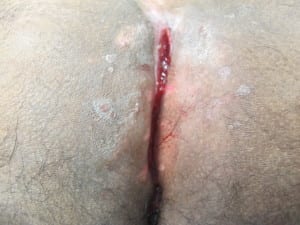What is pilonidal disease?
Posted February 28, 2015 in Body Procedures
Pilonidal disease is a chronic infection of the skin and underlying tissues near or on the natal cleft of the buttocks (near the tailbone). This process is also frequently referred to as a pilonidal cyst, although in most cases there is no actual cyst formed. Other terms that more accurately describe the process include pilonidal abscess and pilonidal sinus. There are several theories as to why pilonidal disease occurs, although the exact cause is not clear. It is commonly thought to be the result of hair puncturing and embedding underneath the skin. As such, pilonidal disease more often occurs in men. There are several risk factors which can make someone more susceptible to developing pilonidal disease, including obesity, poor hygiene, excess body hair, and occupations requiring prolonged sitting.

The symptoms of pilonidal disease may range from mild to severe. In some cases a pilonidal abscess may not cause any symptoms at first, and many people may not be aware that they have one. Some people notice a painless lump in the affected area when washing. However, in most instances, symptoms develop at some stage. People with pilonidal disease can experience discomfort or pain, swelling, moisture, odor, or discharge of fluid from the tailbone. Further, they may experience discomfort with any activities involving direct pressure on the tailbone, such as riding a bike.
Once the hair become trapped underneath the skin, it initiates a process of irritation and inflammation of the tissues, resulting in the formation of an abscess. Some people have recurrence of their pilonidal cyst or abscess, usually because the infection never completely clears. As a result, the symptoms of pain, swelling, and discharge of fluid can occasionally flare up. There are no medications that can eradicate pilonidal disease, and the episodic recurrences will usually not cease until the cyst, abscess, or sinus is treated with an operation.
If there is an acute infection of the pilonidal cyst, then surgical drainage of the abscess is usually required along with oral antibiotics. However, this does not address the underlying cause of the abscess, and a more formative procedure is eventually required to remove the pilonidal cyst and its contents from the body. There are several operations which are utilized to address this problem. The simplest involves cutting out the pilonidal cyst or sinus and allowing the tissues to heal in on their own. Although this method may be effective in reducing the chance of the condition recurring, it may take several months of dressing changes to the wound until it finally heals. Another approach involves excising a small amount of tissue (usually just the pilonidal sinus) and closing the skin. Although this method tends to heal quickly, there is a higher chance of recurrence since the tissues are not widely excised.
In order to circumvent problems with these two procedures, advanced plastic surgery techniques were developed to not only remove a wide area of tissue containing the pilonidal cyst, but to also close the wound simultaneously. This is accomplished through the use of flaps, which are tissues that are rotated or advanced in from the surrounding areas thereby closing the wound. Not only is the pilonidal cyst removed and the wound closed, but the aesthetic result is much better than that when the wound is left open to heal in on its own.
